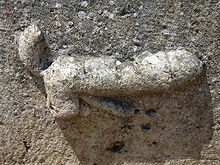Mutunus Tutunus
Mutunus Tutunus or Mutinus Titinus was a Roman deity associated with the marriage rite of confarreatio. He seems to have been represented ithyphallic or as a phallus, and in this respect corresponded to the Priapos of Greek mythology. Presumably, however, his cult image was not a human figure or herm, but a phallus with pronounced testicles. It has been assumed that the Fascinum is related to Mutunus Tutunus in a similar way as the herm is related to Mercury.
On his cult image, according to Christian authors, the bride sat down in the course of the wedding ceremonies, so that the god deflowered her. In particular, the size of the phallus is painted. Thus it is written in Augustine:
"Is there not also Priapus present, the supermasculine one, on whose monstrous and vile member the newly-wedded had to sit, according to the most honorable and pious custom of the matrons."
- Augustine: de civitate Dei 6,9
How much of these polemical reports can actually be traced back to Varro is hard to decide.
It is also uncertain whether there is actually a double name, since Varro writes of a Mutunus vel ("or") Tutunus, whereas the Christian authors write of Mutunus et ("and") Tutunus, i.e. that actually Mutunus and Tutunus are two traditional forms of the god's name, about which there was already ambiguity in Varro's time. Possibly the name Mutunus is related to mutto, with the meaning "penis" attested, and muttonium, the name for a phallic amulet.
According to Festus, there was a sanctuary of Mutunus Tutunus on the Velia, which was visited by Roman ladies alone, wearing a toga praetexta, a ceremonial garment actually reserved for high-ranking persons and priests, from which we can conclude that they were representatives of a patrician priesthood.
Another possible interpretation is again related to the wedding customs: Not only priests and dignitaries wore the toga with the purple stripe, but also boys until the day they became men and put on the toga virilis. For girls, the corresponding day was the wedding day, on which they took off their children's clothes and, veiled (capite velato) in the toga praetexta, offered a sacrifice, possibly in the sanctuary of Mutunus Tutunus, where the symbolic defloration described above could have taken place, but this can no longer be said exactly because of the state of the surviving text.
The fate of the sanctuary is also unclear: this venerable shrine seems to have been pulled down by Gnaeus Domitius Calvinus and a bathing establishment erected in its place, certainly not without the consent of Augustus, whose faithful follower Domitius Calvinus was. The passage in Festus is much corrupted, and the extract handed down in Paulus Diaconus is very brief.

Fascinum (from Clunia near Burgos)

Denarius of Quintus Titius Mutto, believed to show a bearded Mutunus Tutunus.
See also
- Wedding (Roman Antiquity)
Search within the encyclopedia